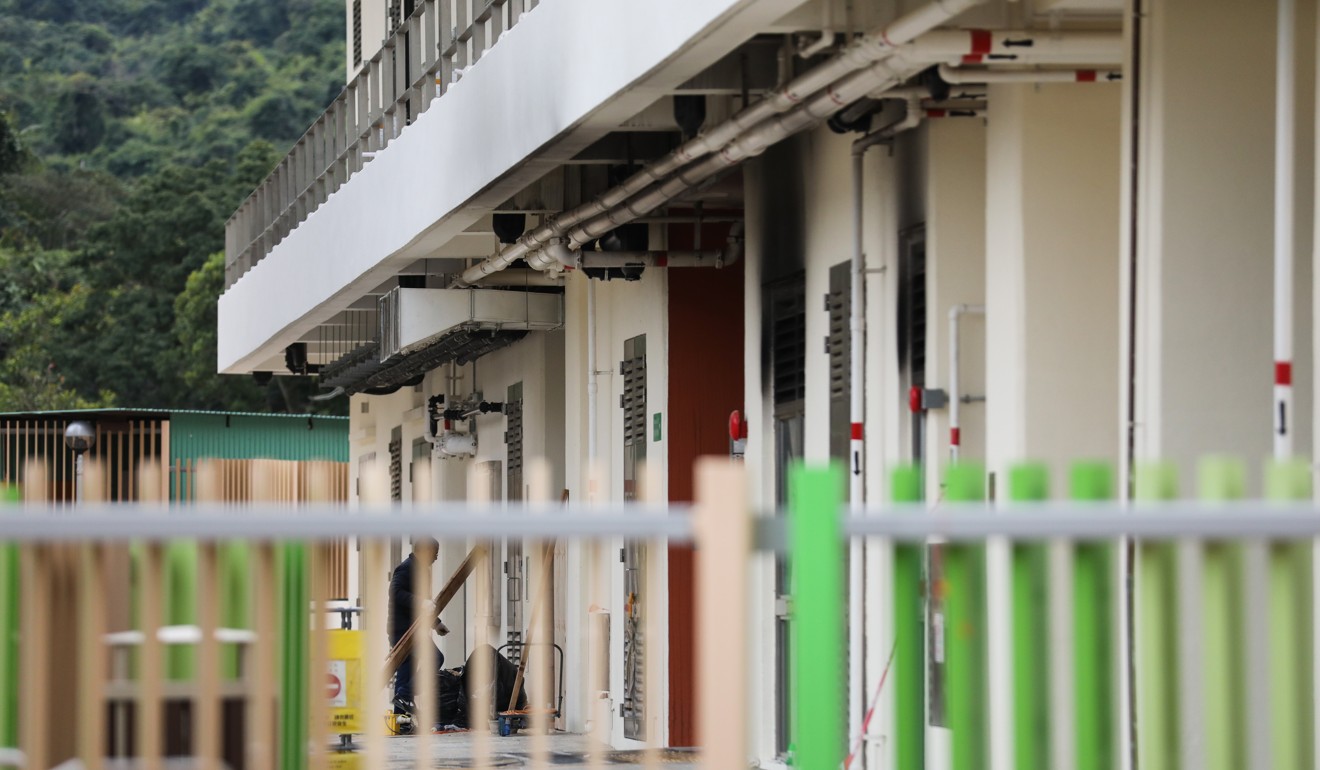
China coronavirus: fear of infection, lack of consultation drive defiance over Hong Kong quarantine plan
- Assurances that those known to be infected would not be sent to Fanling fail to convince many who spoke to the Post
- Some flats inside of one of the estates’ two residential blocks were already equipped with beds and small appliances
A day after dozens of protesters clashed with police and set buildings ablaze with petrol bombs, angry residents in the border town of Fanling vowed to fight on if the Hong Kong government moves forward with plans to use a public housing block there as a quarantine site for the coronavirus epidemic.
Each of 15 residents living near the newly built housing block who spoke to the Post on Monday voiced opposition to the proposal, citing fear of infection and a lack of consultation by the administration.
Fai Ming Estate, which the government said would be used as a potential quarantine site, consists of two residential blocks – Tai Fai House and Sing Fai House. The Post found flats inside the latter already equipped with beds and mattresses as well as small appliances like table fans and water boilers.
Speaking on a radio programme on Monday, Secretary for Food and Health Sophia Chan Siu-chee clarified that while it was still undecided how those quarters would be used, they would not house patients with confirmed infections, but more likely medical staff or those who had come into contact with victims but showed no symptoms.
That distinction left many Fanling residents unmoved, particularly those living in Yung Shing Court, a 20-year-old public housing estate located next door to Fai Ming Estate.
Wan Tsui, 56, said she was worried, as the flat where she has lived for 20 years sits directly across from the potential quarantine site.
“Our window faces the windows of [Sing Fai House], with maybe only 200 metres’ (660 feet’s) distance,” she said. “The government is forcing people [to turn] against them.”
The entirety of Hong Kong is facing this crisis and we should not be selfish … But at least tell us why here is the best option
Leo Lee Ka-ho, 26, who has also lived in Yung Shing Court for two decades, said while it was wrong for residents to adopt a “not in my backyard” mentality, they still deserved an explanation.
“The entirety of Hong Kong is facing this crisis and we should not be selfish … But at least tell us why here is the best option,” he said.
At least two residents in the development said if the government presses on with its plan, they were prepared to engage in non-cooperative movements such as sit-ins.

One of them, a woman surnamed Cheung, said: “All of us residents will oppose [if the government insists on the plan]. They want us to die.”
A Post tour of the surrounding area found at least two secondary schools, two primary schools, two shopping centres and a home for the elderly located in the vicinity.
The Wah Ming public housing estate and a private residential complex named Flora Plaza also sit about 1km (0.6 miles) away from Fai Ming Estate.
One Flora Plaza resident, who gave his name as Billy Wong, said he feared the epidemic would take hold in the area if even a single person were infected with the virus by those living in the quarantine site.
“The virus is transmitted human-to-human, but there is no cure so far. Of course I’m afraid … There is no way the government can do this [set up a quarantine site] here. Please go somewhere else, far away from residential areas,” he said.

A 73-year-old resident at Wah Ming Estate, who gave his surname as Chan, also urged the government to reconsider its plan, saying that many among tens of thousands of people living nearby were elderly, and therefore more vulnerable to illness.
Another Fanling resident, Elaine Lau, pointed to the experience of Amoy Gardens during the 2003 Sars epidemic, when up to 300 residents in the densely populated housing complex in Kowloon Bay were infected by the deadly virus.
Fai Ming Estate’s status as a potential quarantine site, meanwhile, has left the public housing applicants who had been allocated some of its 900 flats wondering what comes next. Some had been expected to move in as early as this year.
The Housing Authority said on Sunday that special arrangements would be offered to those affected, but could not yet say when.
Government officials are set to attend a North District Council meeting on Wednesday to further discuss plans for Fai Ming Estate, while the housing block’s transformation into a quarantine facility has been temporarily suspended until then, the Centre for Health Protection confirmed on Sunday night.

